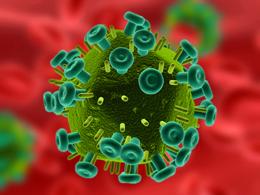-
le VIH se cache
Hiding place for HIV revealed
The AIDS virus escapes treatment inside progenitor blood cells.
 HIV hides away inside progenitor blood cells.S. Kaulitzki/ iStockphoto
HIV hides away inside progenitor blood cells.S. Kaulitzki/ iStockphotoHIV infection can persist despite treatment because the virus stays dormant inside cells, ready to multiply again after therapy stops. Now, researchers have discovered that progenitor cells that develop into immune cells are an important reservoir for the virus.
These cellular reservoirs are resistant to the immune response of the host and the highly active antiretroviral therapy (HAART) administered to patients. That means the virus can attack white blood cells known as CD4+ T lymphocytes — which help the body to mount an immune response — after treatment.
"There are so many instances where patients stopped taking drugs and the virus rebounded," says Kathleen Collins, a cellular biologist at the University of Michigan in Ann Arbor, lead author of the study published in Nature Medicine1 today. "There is no way to get people off the drugs." HAART can stop the spread of the virus by preventing the viral genome from integrating into new cells. The combinations of drugs used don't attack the cell that makes copies of the virus, but they can prevent the newly made virus from infecting more cells.
The researchers show that HIV can target haematopoietic progenitor cells (HPCs) from the bone marrow before they give rise to white blood cells.
The team took these cells from HAART-treated patients who have shown no detectable traces of the virus for at least six months. When the researchers forced the cells to differentiate into white blood cells in the lab, they found the HIV genome in these cells in about 40% of the donors. They also took cells from the bone marrow of healthy people and showed that the virus killed some cells, but in other cells the virus integrated into the cells' chromosomes and did not reproduce. These cells grew as if they were uninfected by the virus.
"If the drugs are on-board, the virus is still being made but it is not doing much harm because it can't spread," says Collins. In the absence of the drugs, the infection renews, and patients need to return to the therapy and stay on it. "If you shorten the therapy even to two years, that would dramatically change things," she says, by bringing down costs and allowing the therapy to be used more widely in poor countries.
Dangerous dormancy
Previous research2 conducted by Robert Siliciano, a molecular biologist at Johns Hopkins University in Baltimore, Maryland, established that CD4+ T cells can be latent reservoirs for the virus. But he and his team showed that residual levels of virus in the blood of patients on HAART were often dominated by a virus population they couldn't find in CD4+ T cells. The new work may provide an explanation of that observation, Siliciano says.
If HIV is in these long-lived progenitor cells, the reservoirs can last for the entire life of the host cell. But there may be a way to target these reservoirs, says Collins "One way is to find a way to push the cells from latency to go into an active infection while patients are still on their drugs," she says.
This work helps us understand the obstacles to eliminating the virus that survives despite effective antiretroviral treatment, says Clyde Crumpacker, a virologist at Harvard University in Boston, Massachusetts, who works with HPCs and HIV. Other work, he says, has suggested that HPCs are resistant to HIV infection3. "One of the hopes has been that HPCs are a protected sanctuary," says Crumpacker. "This paper forces us to reexamine that hope." Siliciano adds, "Eradication efforts will only be successful if all of the reservoirs for HIV are identified and eliminated."
-
Commentaires
Mon petit cahier de sciences naturelles

